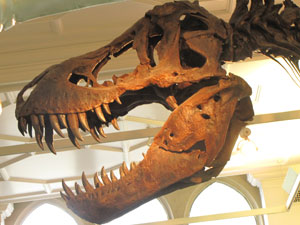Fossils and Bones - a new workshop for KS1 and KS2 Time Trips home page
TEMPORARY WEB PAGE - MORE DETAILS TO FOLLOW
- Emma Furness, Teacher at Norris Bank Primary, Stockport
'A monster of a workshop.'
-Shaun Stirling, Teacher at Norris Bank Primary, Stockport - see his full comments below

Above: T rex made by year 4 at Norris Bank Primary, Stockport, July 2011.
Time Trips is taking a much bigger step back in time than before - not thousands of years, but millions - to prehistoric life.
Get children excited
about science by looking at fossils and dinosaurs!
· Links to several
National Curriculum topics:
Unit 2C – Variation
Unit 4A – Moving and
growing
Unit 4B – Habitats
Unit 6A –
Interdependence and adaptation
· Excellent visual
learning tools – real fossils, models, photos
· Hands on activities –
great for learning, teamwork, and amazing displays
· Handle 3 real fossils (plant, shark's tooth and ammonite) in pairs, try to identify, and discuss features and what a fossil is
· Look at over 20 fossils (including accurate replicas) of different types of animals (& 1 or 2 plants) and identify, using pictures of the living animal; also identify an adaptation for each (e.g. wings to fly, shell for protection) (see examples below of the sorts of fossils we will look at and make)
· Paint accurate plaster casts of fossils - up to 23 different types, with each child/pair doing one, so you have a rich and varied 'museum display' for your classroom
· Look
at real bones, as well as pictures of skeletons, and learn: types and
functions of bones, teeth; how to tell type of animal (e.g. predator or
herbivore) and habitat; how muscles work
· Make a complete, full size skeleton of an enormous animal using templates and paper (white and brown), with a choice of Tyrannosaurus rex (12X4m) or Triceratops (9X3m) (see pictures above and below). Children work in pairs to cut out bones and stick them on a background, and the whole is pieced together at the end and displayed on the wall of your school hall.
 Left: What the triceratops will look like.
Left: What the triceratops will look like.
Lesson Plan
· Handle 2 real fossils* (plant and ammonite) in pairs, try to identify, and discuss features and what a fossil is
· Look at 20 fossils (including accurate replicas) of different types of animals (& 1 or 2 plants) and identify, using pictures of the living animal - also work out habitat (land, water, air)
· Paint
accurate plaster casts of fossils - many types
Contact details: Tony North, Time Trips, tel: 0161 438 6634/07754 406422, email: tnorth67@hotmail.com
Comments from a Y4 teacher about the afternoon session:
'The children at our school were amazed to arrive one morning in the last week of term to see a life-sized tyrannosaurus rex prowling across the back of our school hall. This beast had been put together the previous afternoon by children in Year 4/5 as part of a workshop delivered by a regular visitor to our school, Tony North. In the past Tony has delivered engaging and hugely popular curriculum workshops on historical topics but none of us were quite ready for his latest idea.
Following a useful classroom presentation on the skeleton, Tony took the children into the hall where they worked for the rest of the afternoon as paleontologists slowly uncovering the remains of an enormous prehistoric dinosaur. In small groups, differentiated according to the ages and abilities of the children in the class, they drew from stencils, cut out and assembled a myriad of paper bones which were then arranged to form the dinosaur skeleton. I was impressed with the level of engagement the children showed on a complex and demanding task over a lengthy period. They also worked cooperatively, both within the small groups working on different parts of the dinosaur and as a class piecing the parts of the whole together.
And the end of the day Tony showed great persistence in
hanging the completed t-rex so that the children who had worked on
it, and the wider school, could be awed by the sight of this giant
when they arrived at school the following day. A monster of a
workshop.'
-Shaun Stirling, Teacher at Norris Bank Primary, Stockport











